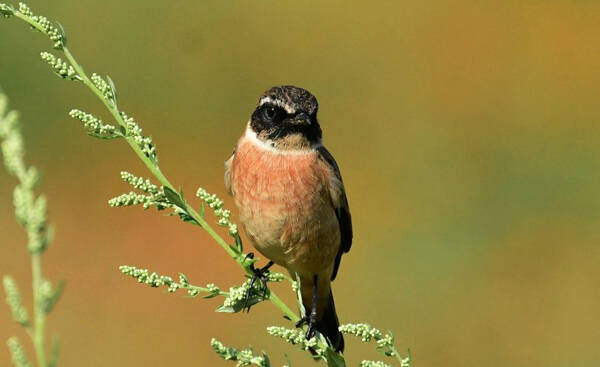Saxicola insignis
IUCN
LCBasic Information
Scientific classification
- name:Saxicola insignis
- Scientific Name:Saxicola insignis,Hodgson's Stonechat,Ho's Tree Rock Bird
- Outline:Songbird
- Family:Passeriformes Flycatchers Lithopteridae
Vital signs
- length:14-15cm
- Weight:22g
- lifetime:5-10years
Feature
The male has a black upper body with large white wing spots, white upper tail coverts, white chin and throat, and the rest of the lower body is rusty red.
Distribution and Habitat
Presence (breeding grounds): Mongolia, Russia (Central Asia Russia). Presence (non-breeding grounds): India, Nepal. Presence (passages): Bhutan, China (Alashan in southwestern Inner Mongolia, Zhaling Lake in Qinghai, and Zaduo in the south). Presence (habitat): Kazakhstan. White-throated rockhopper is a highland shrub grassland bird. It is mainly distributed in plateaus and high mountain bare rock shrub areas above 2,000 meters above sea level, especially in rocky shrub grasslands near river valleys or valleys.
Appearance
The male bird's winter plumage is generally black with narrow brown feather edges on the forehead, top of the head, nape, front of the eyes, ear feathers, and sides of the head. The back of the neck, back, and shoulders are black with wider brown feather edges. The wings are black, the large coverts are white, the flight feathers are black, and the base of the flight feathers is white. Together with the white large coverts, they form a large white wing spot on the wing. The inner secondary flight feathers have brownish-white feather edges. The upper coverts of the waist and tail are white, and the tail is black with narrow brown terminal spots. The chin and throat of the lower body are white with a slight tan, and the rest of the lower body is rusty. The upper chest is darker and often has a few black spots. The abdomen is slightly lighter, the undertail coverts are brownish-white, and the axilla and underwing coverts are white with black bases. The summer plumage is basically sim
Details
The white-throated stonechat is also known as Hodgson's Stonechat. It is a small bird of the family Flycatcher and the genus Stonechat. It has no subspecies.

The black-throated rockfish (Saxicola torquatus), a similar species to the white-throated rockfish, is smaller in size, with black chin and throat instead of white, and the difference is also very obvious, making it easy to identify in the wild.
The white-throated rock beetle often moves in pairs or small groups, mostly living on rocks or bushes. It is solitary. It has the typical characteristics of rock beetles, but mostly feeds on the ground. It perches on the top of bushes and jumps to catch insects. The white-throated rock beetle mainly feeds on insects and insect larvae, and also eats plant fruits and seeds. The call is monotonous and crisp. It makes a metallic "tek-tek" sound when warning.
The breeding season of the white-throated rock beetle is from May to August. It often breeds in pairs or small groups. During the breeding period, the male bird stands on the top of bushes or high rocks and calls, and occasionally flies into the air to sing. It builds a nest in the cracks of rocks. The nest is cup-shaped, mainly made of moss and fine grass stems and leaves, and padded with animal hair. Each clutch usually contains 5 eggs. The eggs are blue-green with ochre-brown spots, especially dense at the blunt end, and the size of the eggs is 20.8-21.0 mm × 15.9-16.0 mm (Dement’ev and Gladkov 1954).
The white-throated rock croaker has a narrow distribution range in China, is rare in number, and has few preserved specimens. The population is also small worldwide. According to records and surveys by BirdLife International in 2001, the estimated number of adult individuals is 2500-9999. This is equivalent to 3750-14999 individuals. Wintering populations are often seen in several protected areas, including Kaziranga, Corbett and Manas National Parks in India, and Lumbini Crane Sanctuary, Chitwan National Park and Sukala Pantha Wildlife Sanctuary in Nepal. The protected areas in Nepal may be where the population density is the highest.
The main threats to the White-throated Stonecrop appear to be rapid and extensive loss and modification of grasslands in wintering grounds due to drainage, conversion to agriculture (although it appears to be partially adapted to sugarcane), overgrazing, harvesting of forage for thatch production, and inappropriate grassland management in protected areas. Severe flooding in the Yarlung Zangbo River basin, coupled with the destruction of forests in the basin, has further damaged its suitable habitat.
Listed on the IUCN Red List of Threatened Species (IUCN 2018 ver 3.1) - Vulnerable (VU).
Listed on the Convention on the Conservation of Migratory Species of Wild Animals (CMS) - Appendix II.
It has been listed as a global endangered bird by Bird Life International and is protected.
It is included in the "National List of Terrestrial Wildlife with Important Economic and Scientific Research Value" (item 450) issued by the State Forestry Administration of China on August 1, 2000.
It is included in the second level of China's "National Key Protected Wildlife List" (February 5, 2021).
Protect wildlife and eliminate game.
Maintaining ecological balance is everyone's responsibility!








